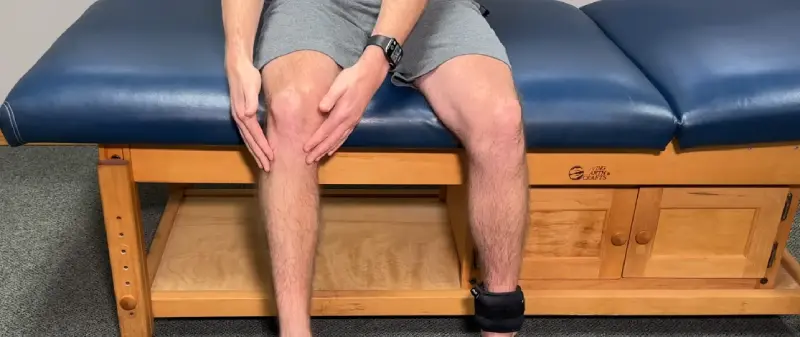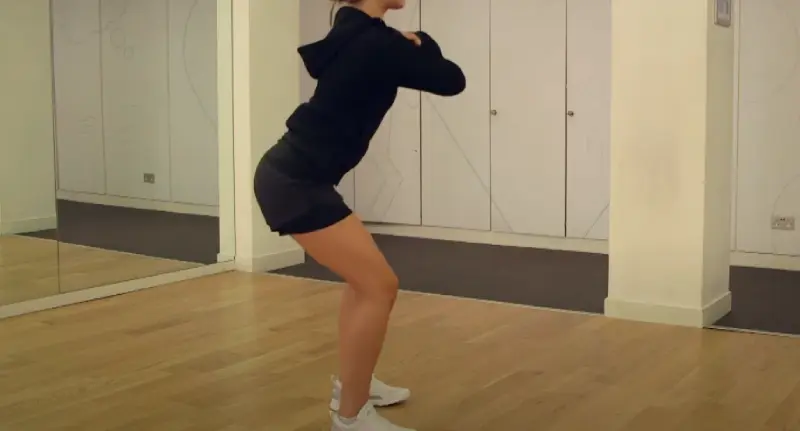Knee fat can accumulate either inside or above the knee because of weight gain, genetics, age, or hormonal changes. Regrettably, knee fat is resilient and is not easily shed through diet and exercise alone.
One of the easiest ways to tone your knees is to cycle. Keep your bicycle’s speed at an average level. You won’t see results if you constantly switch speeds! Start slowly and prioritize consistency instead of changing speeds erratically.
We will explore the science behind how cycling helps reduce knee fat, the factors that make it an effective exercise, and provide you with practical tips for getting the most out of your cycling routine.
Does Cycling Get Rid Of Knee Fat: 4 Workout Benefits

Cycling is an effective way to target and eliminate knee fat. We’ll look closer at how cycling can help you eliminate knee fat and improve your overall health and fitness.
Benefits of Cycling for Knee Fat
Cycling is a low-impact exercise that targets leg muscles such as quadriceps, hamstrings, and calves. This can help to burn fat in the knee area and promote a more toned and defined look. But that’s not all–cycling offers a range of benefits for knee fat and overall health, including:
- Increased Heart Rate: Cycling raises your heart rate, which boosts your metabolism and enhances fat-burning.
- Weight-Bearing Exercise: Cycling is a weight-bearing exercise that increases bone density and reduces knee injuries, which can contribute to knee fat.
- Low-Impact: Cycling is low-impact, which means it’s easier on the joints and muscles than high-impact exercises.
- Easy to Incorporate: Cycling is an accessible and convenient exercise that can be easily incorporated into your lifestyle, whether commuting to work or taking a leisurely weekend ride.
Tips for Cycling to Target Knee Fat
Cycling is an effective method for reducing knee fat. It’s essential to do it correctly to maximize your results. Here are some tips to keep in mind:
- Use proper form: Make sure you use the correct form when cycling. This includes maintaining a steady and controlled pace, aligning your knees with your toes, and engaging your core muscles.
- Vary your intensity: To maximize fat-burning, vary your intensity during cycling sessions. You can do this by increasing your speed or resistance for short bursts, then returning to a more moderate pace.
- Incorporate strength training: Besides cycling, strength training exercises targeting your leg muscles can help maximize fat-burning and overall toning.
- Stay consistent: Staying consistent with your cycling routine is essential to see the best results. Aim to cycle for at least 30 minutes daily, 3-4 times weekly.
Tips For Reducing Knee Fat While Cycling In Different Positions
Various cycling techniques can help target and reduce knee fat in different positions. Integrating specific cycling strategies is key to effectively trimming fat above, around, or within your knees.
Fat Above Knees
Cycling upright while maintaining a moderate resistance level can engage the quadriceps, the muscles located above the knees. An individual can potentially reduce fat above the knees by pedaling consistently and controlled. Adjusting the bike seat to a suitable height is essential to ensure proper quadriceps engagement during the cycling motion.
Fat Around Your Knees
When cycling, it’s helpful to keep a smooth and circular pedaling motion to engage the knee muscles. Interval training can be incorporated into a cycling routine to target fat accumulation around the knee area.
This involves alternating between high-intensity cycling and recovery periods, promoting calorie burning and reducing knee fat.
Inner Knee Fat
Inner knee fat can be addressed through cycling by paying attention to pedal stroke efficiency. Emphasizing the push and pull phases of the pedaling motion can engage the inner thigh muscles, potentially aiding in reducing fat in this area.
Adjusting the foot position slightly inward during the pedal stroke can further target the inner knee region, contributing to a more comprehensive workout for that specific area.
Additional Tips For Hiding Fat Knees
Many individuals strive to achieve more sculpted legs and reduce fat around the knee area. In this blog post, we will explore the effectiveness of cycling in addressing knee fat.
Lose Weight in General
Losing weight is often the first step in shaping the legs and reducing fat around the knees. A balanced diet and regular physical activity. People may notice reduced knee fat accumulation by shedding excess weight.
Run or Jog
Running or jogging can be instrumental in toning the legs and promoting overall weight loss. These high-impact cardiovascular activities can help burn calories and contribute to a leaner, more sculpted leg appearance.
Ride a Bike
Exercises like cycling are low-impact and help reduce knee fat. It provides a cardiovascular workout while engaging the leg muscles, helping tone and strengthen the lower body. Regular cycling can contribute to a more defined leg shape and assist in managing knee fat.
Lunges
Incorporating lunges into an exercise routine can target the muscles in the legs, including those around the knee area. Exercises like this can improve lower body strength and tone appearance in the leg region.
Squats

Squats are effective in strengthening the quadriceps, hamstrings, and glutes. By incorporating squats into a workout regimen, individuals can tone their leg muscles and reduce fat around the knees.
Jumping Rope
Jumping rope is a high-intensity cardiovascular exercise that engages the leg muscles. This activity can help burn calories and promote weight loss, contributing to a slimmer leg profile.
Walking
Simple yet effective exercise for overall health and weight management. It engages the leg muscles and can contribute to
calorie burning, which may help reduce fat around the knees over time.
Cycling and Knee Fat: Factors that Affect the Effectiveness
The effectiveness of knee fat loss depends on various factors. Here are some crucial factors that affect the efficiency of cycling for knee fat reduction.
Intensity and Duration of Cycling Sessions
Cycling intensity and duration are vital in determining how much knee fat you can burn. When you cycle at a higher intensity, your body has to work harder and consume more energy, leading to more significant calorie and fat burning.
On the other hand, longer cycling sessions can also contribute to more substantial knee fat reduction by prolonging the energy expenditure and targeting the knee area. Therefore, to maximize the knee fat-burning potential of cycling, aim for longer, more intense sessions.
Incorporating Resistance Training
Resistance training during cycling can act as a catalyst to enhance your knee fat reduction efforts. It involves adding resistance to your cycling routine, such as hill climbs or using a stationary bike with resistance settings.
This way, you challenge your body and burn more calories, even after your cycling session. Build muscle and burn fat by including resistance training in your cycling routine, leading to a toned and sculpted physique.
Proper Nutrition and Calorie Deficit
No matter how intense or prolonged your cycling sessions are, you will only see the desired results if your diet is checked. Proper nutrition and a calorie deficit promote fat loss by limiting your calorie intake and ensuring you consume the proper nutrients. To create a calorie deficit, you must expend more calories than you consume.
You can achieve this by reducing portions, opting for healthier food, and incorporating intense workouts like cycling into your fitness routine. Eating a balanced diet with adequate protein, fiber, and healthy fats can also help to keep your body fueled and support muscle building.
Cycling Gets Rid of Knee Fat: 3 Tips and Tricks

Cycling alone may not be enough to achieve the desired results. Here are some tips and tricks to take your cycling routine to the next level and optimize your weight loss journey.
Vary Your Cycling Routine
Cycling can be both fun and effective when done correctly. Doing the same daily cycling routine can lead to plateaus, and your body gets accustomed to the exercise. Switch up your training occasionally to ensure your body stays challenged and you make the most of every ride. Here are some ways to do that:
- Change the intensity: Intervals and hill workouts are excellent for cardio and muscle burn. Slow down and take it easy on flat terrain or up your cadence and resistance on an incline.
- Alternate between indoor and outdoor cycling: Indoor spin classes are trendy now, but remember to mix it up with a refreshing outdoor ride that can also change scenery.
- Try a new route: Taking the same paths every time you hit the road can be tempting. Experimenting with new ways can excite your rides and keep things fresh.
Proper Bike Fit
A correctly fitted bike can make all the difference in avoiding injuries and increasing your cycling ability. No matter how much you love your bike, if it is not adjusted to fit your body type, it can lead to unnecessary pain, loss of power, and reduced performance. Here’s how to ensure your bike is well-suited to your body:
- Saddle height: Your seat’s height is the most crucial element of bike fit. It determines how much power you can output. Ideally, when pedaling, your knee should be straight, with a slight bend of about 5-10 degrees.
- Saddle position: Your saddle should be adjusted so that your knee is directly above the center of your pedal when your foot is at the bottom of the pedal stroke. This ensures maximum power output and helps to prevent injury.
- Handlebar position: The handlebars should be at a height that is comfortable for you but not too high that it causes too much pressure on your arms.
Strength Training for Targeted Results:
Cycling is great cardio, but more is needed to tone your legs and specifically burn knee fat. Therefore, incorporating strength training exercises, such as lunges, squats, and leg presses, can help you tone muscles and target the areas around your knee. Here’s how to incorporate strength training to complement your cycling routine:
- Schedule strength training days: Include training sessions at least twice weekly to see results on your leg muscles.
- Side leg lifts and seated leg extensions are practical exercises to strengthen your knees and improve knee joint flexibility.
- Try out resistance bands, which provide a safe and straightforward way to build muscle strength that compliments cycling.
Conclusion
Cycling is an excellent exercise for reducing knee fat. By understanding the factors that make this exercise effective, such as the muscles it engages and the boost it gives your metabolism, you can develop a cycling routine that targets knee fat and leads to visible results.
Incorporating resistance training, maintaining a calorie deficit, and varying your cycling routine can help you lose weight. So whether you prefer to ride indoors or outdoors, hop on your bike and start pedaling towards slimmer, healthier legs.
FAQs
How To Get Rid of Knee Fat In a Week ?
Fat loss around the knees takes time since sustainable weight loss happens over an extended period. However, implementing targeted exercises such as squats, lunges, cycling, and maintaining a balanced and healthy diet can contribute to gradual fat reduction.
It’s essential to approach fat loss with patience and a focus on overall health rather than aiming for rapid changes.
What To Do If You Want To Lose Knee Fat Overnight
Fat loss won’t happen overnight; achieving significant fat loss isn’t unrealistic. Fat loss, particularly in specific areas like the knees, requires a sustained effort over time through consistent exercise and a balanced diet.
While specific methods such as staying hydrated, avoiding high heels, and engaging in moderate physical activity may contribute to overall health, it’s essential to approach fat loss from a long-term perspective.


